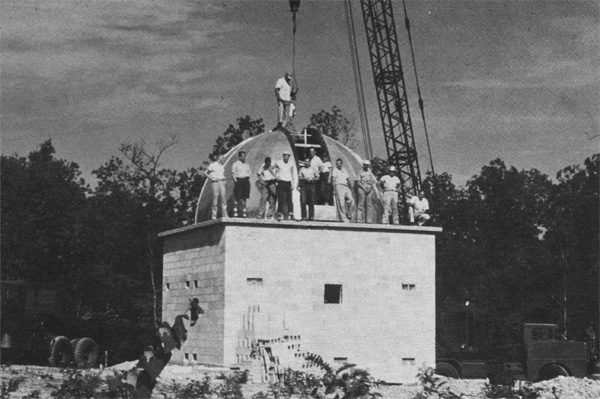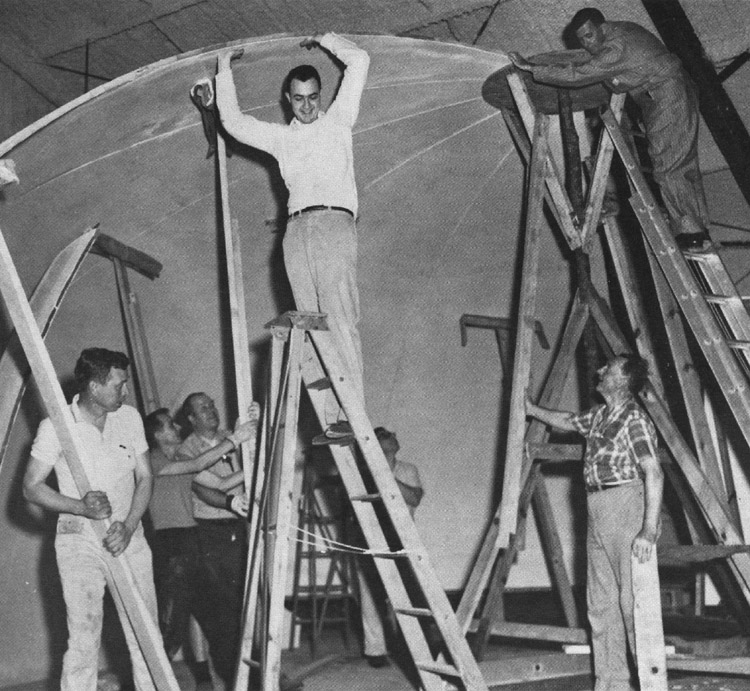How It All Began
The following was taken from a VBAS brochure published in 1979 to commemorate the 25th Anniversary of its formation:
IN THE FALL of 1954, 16-year-old Sammy Pruitt sold several Huntsville high school classmates on the idea of forming a club to study astronomy. Failing in their initial try to interest more boys of their own age, the group turned their efforts toward soliciting the help of a few scientists at nearby Redstone Arsenal. Among the early responders from the Army’s famous missile team were Dr. Wernher von Braun and Dr. Ernst Stuhlinger.
The society had its beginnings in a series of informal meetings at the home of Dr. Martin Schilling, another Redstone Arsenal rocketeer, during the winter of 1954 and early spring of 1955. It was at one of these early meetings that a decision was made to form an association and buy a large telescope. While Dr. von Braun went shopping for a suitable scope, plans were made to build an observatory. Wilhelm Angele, another Army missile expert, volunteered to design the observatory building.
The first temporary officers and directors were elected April 4, 1955. They were as follows:
President……..…Dr. Wernher von BraunVice-President………...B. Spencer Isbell
Secretary……………….. Samuel F. Pruitt
Treasurer………….........Erwin W. Priddy
Directors..……….... Dr. Ernst Stuhlinger
Charles T. Paludin
Gerd Schilling
Conrad D. SwansonDean Breasseale
After aerial reconnaissance to pick the best location, Paludin and Stuhlinger were successful in obtaining from the State of Alabama a 13.5-acre tract of land in Monte Sano State Park. State officials agreed to a nominal rental of $1 for a 25-year lease, renewable at the group’s option.
As soon as the land was theirs, members eagerly began to prepare the site for construction. Among the most active workers were Dr. von Braun, Dr. Stuhlinger, Priddy, Swanson, Isbell, Gerhard Heller, Eugene Mechtly and George Ferrell.
The Rocket City Astronomical Association took shape during the latter months of 1955. A constitution and by-laws were agreed upon, and, in due course, the RCAA was incorporated.
In December 1955 the charter officers and directors were selected. Von Braun, Isbell and Priddy were re-elected president, vice-president and treasurer, respectively. Bradspies was elected secretary and Ferrell corresponding secretary. Stuhlinger, Angele, Heller and Swanson were also elected to the Board of Directors.
One of the biggest problems in the construction of the observatory was the fabrication of the dome. Designing and building the heavy hemisphere, along with the slit mechanism, mechanical drives and supporting structures, was a formidable task, which was finally completed under the leadership and ingenuity of Wilhelm Angele and Gerhard Heller.
At about the same time, Dr. von Braun found a bargain. A 16.5” Cassegrain reflecting telescope was purchased from a sympathetic seller in California for about $600 (the mirror alone is said to be worth $2,000).
Construction then began on the observatory building itself. Work crews gathered every Wednesday evening, and on many weekends, with Dr. von Braun the chief organizer. Quincy Love supervised early construction work on the building and spent much of his time working at the site. He was given considerable help by Mechtly, Priddy, von Braun, Stuhlinger, Ferrell, Heller, Isbell and several others, including many junior members.
Several tons of concrete were poured to form the telescope mount and supporting ring for the dome. The reinforced steel and concrete ring supporting the dome measures 24 feet square outside and has an inside diameter of 28 feet. The dome sits on rollers, and is fully controllable at the eyepiece by remotely controlled electric motors. The slit rolls back over the top of the dome to expose the heavens.

Thanks to the generosity of many local business firms and interested individuals, more than $3,000 in cash and materials was donated. The complete plumbing, septic and electrical systems were designed and built by the members themselves. All work except the long ditch for the water main was done by hand.
Although the observatory construction began in April 1956, it was sufficiently advanced by September to permit observation of the direct opposition of Mars on September 6 when the planet was closer to Earth than it had been in 17 years and would be for another 15 years. These early observers were delighted to learn that their countless hours of work had paid off. They now had a first-quality instrument that yielded images of Mars and other celestial objects much more detailed than those of their smaller telescopes and binoculars. Needless to say, the telescope has seen extensive use over the years.
In 1960 the Board of Directors accepted a proposal made by the late Clarence Ellis to build a 21” telescope, to upgrade the 16.5” facility. Wilhelm Angele quickly responded by designing and building a large mirror grinding and finishing machine. Ellis used this machine to grind, polish and figure the 21” Pyrex mirror blank in 1965. Richard Hoover tested the completed mirror and certified that the surface was everywhere within 1/20 wavelength of visible light of the desired curve — an excellent achievement. The secondary mirror, which has a hyperbolic shape, was ground and figured by Dan Roberts.
On nights of good seeing, the excellent optics of the 21” telescope perform at their best. Angular resolutions of 2 seconds of arc or better are achieved, and deep-space objects are always spectacular in a dark sky.
The mechanical structure of the 21” telescope was donated by Mr. Milton Cummings, of Brown Engineering. In 1972 the observatory dome was insulated to reduce the temperature variation from day to night. Two years later an air conditioning system was installed to further improve temperature stability, which greatly influences the image quality obtained at the eyepiece of the 21”.
At about this same time the Board of Directors decided to honor the distinguished first president of the Rocket City Astronomical Association for his many contributions to astronomy locally. The RCAA was re named the Von Braun Astronomical Society by unanimous vote.
The planetarium is a natural companion to the observatory. It is a very useful tool for teaching astronomy and for revealing the wonders of the sky to the public. The building, a 40 by 40-foot Butler shell, was furnished on the inside by volunteer VBAS members. The biggest job was to assemble the 33-foot diameter dome at floor level and to hoist it up, intact, 7 feet. The hoisting was done by turning simultaneously 16 nuts on 16 long threaded rods. These were bolted to the building’s steel roof beams to support the dome in place.

The heart of the planetarium is a star projector, which creates a realistic recreation of the night sky on the dome above. The projector is a GOTO Model S-2, donated by Mr. Frank Wyle on behalf of Wyle Laboratories on May 25, 1963. Dr. William Mrazek was instrumental in obtaining the major planetarium equipment. There are 32 star projectors of the optical type including con denser systems, star plates and wide-angle projection lenses. A total of 2,500 stars down to the 5th magnitude can be projected by this machine. The star field selections were taken from Norton’s Star Atlas. The projectors are divided into two groups: one for the northern hemisphere and one for the southern hemisphere, each having its own light source. Projection lens systems are also provided for showing the planets, moon, sun, Milky Way, celestial equator, ecliptic and the local meridian. An arrow pointer is used to indicate features of interest on the dome.
Many of the early planetarium shows were presented by concerned volunteers, including Sherman Stark and Ron Ferdie. Since 1978, Doreen Forsythe has success fully conducted over 100 planetarium shows with about 20 different titles for schools, scouting groups and the public. Doreen is a teacher in the Huntsville school system, and her devotion and hard work have been a real credit to our organization. Many junior members have become involved with the presentation of planetarium programs, under Doreen’s direction. Many special effects accessories have also been built to augment these presentations.
Future plans for the physical facilities include the construction of an addition to house a solar telescope, an optical shop and a small library with a reading/conference room.





